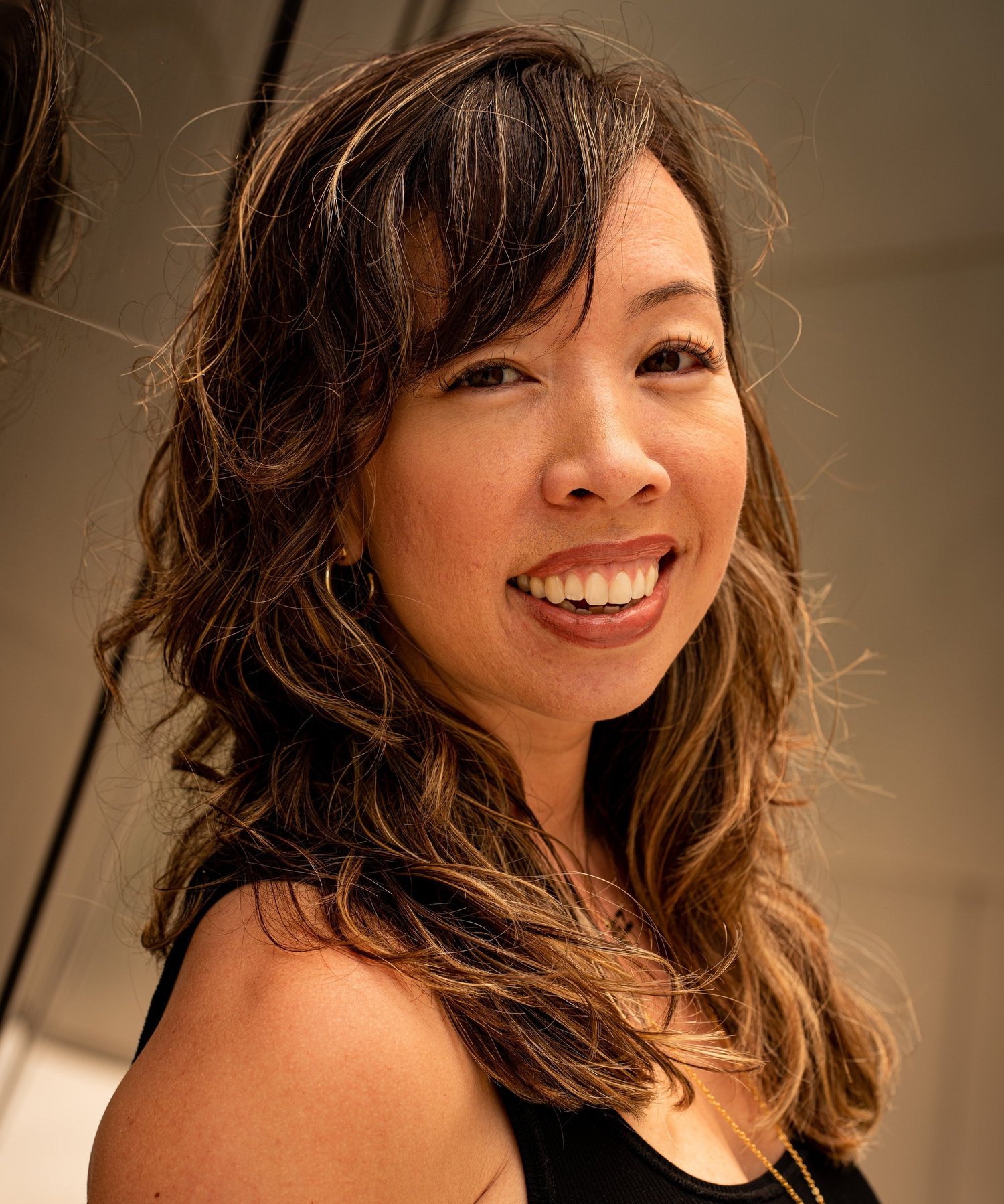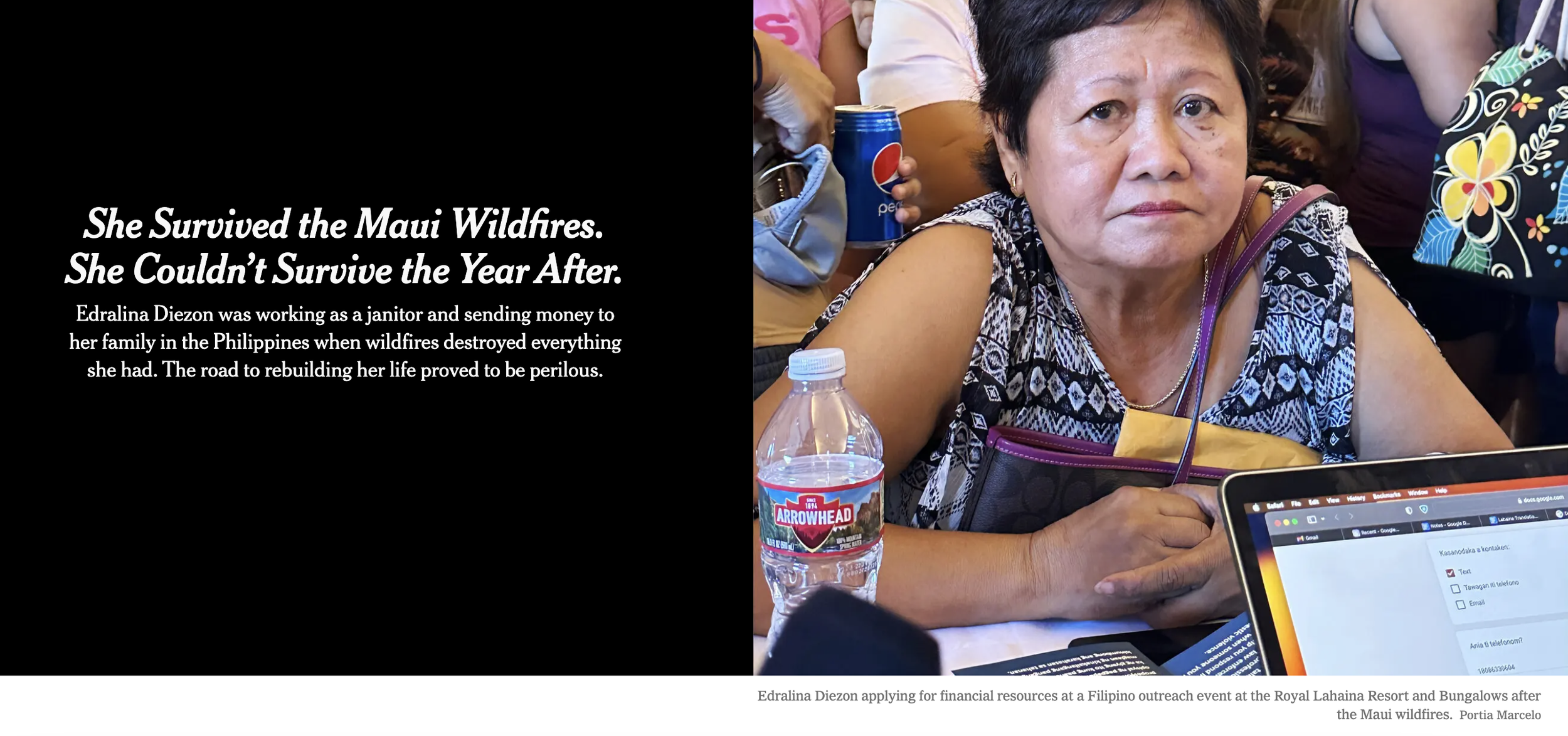Selected Features
Five years after the COVID-19 pandemic first swept across the planet, as many as 20 million Americans and at least 400 million people worldwide currently suffer from long COVID, a debilitating condition that still has no approved treatment and is often misdiagnosed and misunderstood. In their desperate search for answers, two men are bonded by their quest to feel like themselves again. Men’s Health and Apple News, March 2025 issue.
A Merciless Sun
A year ago, Kekoa Lansford watched from a hilltop as the Maui wildfires incinerated his hometown. While others fled to safety, he ran into the flames to save as many lives as he could. Today, the scars from that blaze—one of the deadliest in the U. S. in more than a century—remain. Where do Kekoa and the rest of the survivors go from here?
Men’s Health, September 2024 magazine issue. Listen to the audio version via Apple News.
Edralina Diezon was working as a janitor and sending money to her family in the Philippines when wildfires destroyed everything she had. The road to rebuilding her life proved to be perilous. The New York Times, August 21, 2024. Listen to story via NYT Reporter Reads.
A year after the fire some try to rebuild life in the city known as the ‘ninth Hawaiian island’ – as temperatures top 117F. The Guardian, August 8, 2024.
After hundreds went missing in Maui’s deadly fires, rapid DNA analysis helped identify victims within just a few hours and bring families some closure more quickly than ever before. But it also previews a dark future marked by increasingly frequent catastrophic events. MIT Technology Review, May 2024.
On August 8, 18-year-old Lahaina residents Lanz Aguinaldo and Isabella Lynch woke up to the deadliest U.S. wildfire since 1918. They would end the day clinging to a tree on Maui's roiling shore. Erika Hayasaki reports on the many failures that led there. In print in New York Magazine, Jan. 1, 2024 issue & online at The Cut. Listen to their audio story via Apple News. Story also anthologized in the Best American Science and Nature Writing 2025 book series, edited by Susan Orlean.
When Adri Haia’s hometown was decimated last year, she made it her mission to bring Lahaina back to life, Elle, August 2024.
How can Maui survive future wildfires? History offers some clues.
A year after the deadliest U.S. wildfire in over a century, Native Hawaiian survivors are advocating for change. National Geographic, August, 7, 2024.
After more than a year away from tennis, Naomi Osaka is returning to the court. But this time, the four-time Grand Slam champion is a mother, an executive, and more sure of herself than ever before. InStyle magazine cover profile, December 2023 issue.
Laura and Mari, sisters separated as infants, grew up an ocean apart but with the same penchant for style. Elle magazine. November 2023 issue.
It didn’t matter if she knew you — if you were a professor and Asian American, you were a potential target. The Verge, Oct 25, 2023.
In a political environment where book-banning efforts are being used to drive voter sentiment, librarians find themselves on the front lines. The New York Times Magazine, September 11, 2022 education issue.
The close ties between coroners and law enforcement have fueled an usual and unregulated industry: for-profit forensic examinations. The New York Times Magazine, Sunday, July 11, 2021 issue.
Margaret McKinnon survived a mid-air catastrophe, then became a major researcher of memory and trauma. Now she’s studying how the pandemic will haunt us. WIRED, April 2021 issue (honored as notable selection in The Best American Science and Nature Writing 2022).
Covid-19 has cemented the e-commerce giant’s hold on the economy — but it has also spurred employees all around the country to organize. The New York Times Magazine, Feb. 22, 2021 Cover Story.
My reckoning with Hiroshima, 75 years later. On the 75th anniversary of the A-bomb, a Japanese American writer speaks to one of the last living survivors – and traces connections from Malcolm X to the fight to end nuclear war. Narratively & The Guardian, August 2020.
Machines were supposed to take over tasks too dangerous for humans. Now humans are the danger, and robots might be the solution. MIT Technology Review: July 2020 issue.
Hunting child predators with actress Marisol Nichols. Marie Claire, May 2020 issue.
Chloe Le got a mild case of COVID-19. Her husband, Ted, ended up in the ICU. Chloe spent weeks in a race against a bottlenecked system, trying to donate her plasma to Ted and hopefully save his life. The Atlantic, May 5, 2020.
Emily Rostkowski is an oncology nurse and cancer survivor herself. But now, like so many other healthcare workers, she spends her days in the center of the coronavirus storm. Marie Claire, April 2, 2020.
Editing the epigenome, which turns our genes on and off, could be the “elixir of life.” MIT Technology Review. August 2019 issue. (Supported by the Alicia Patterson Foundation Grant for Science and Environmental Reporting).
We’re starting to understand more about Werner syndrome, a genetic disorder that makes people age too quickly. Could treating it help us all age more slowly? Mosaic/Slate, May 2019. (Supported by the Alicia Patterson Foundation Grant for Science and Environmental Reporting)
Growing Human Organs in Pigs, WIRED. April issue, 2019..
Slate magazine. June 27, 2018. A science journalist responds to Carmen Maria Machado’s short story “A Brief and Fearful Star.” (Supported by the Alicia Patterson Foundation Grant for Science and Environmental Reporting)
Studying twins has long offered insight into the interplay of nature and nurture. Epigenetics is the next frontier. (Supported by the Alicia Patterson Foundation Grant for Science and Environmental Reporting). The Atlantic, May 15, 2018.
Cultural messages tell women that making art and having children are incompatible pursuits. But science suggests that women may become more creative after having kids. The Atlantic, Sept. 13, 2017.
The Atlantic, June 29, 2017. Genetic-sequencing companies are going beyond ancestry and disease risk to offer specific lifestyle recommendations.
Her skin is perpetually on fire. He can't even feel a bone break. Together they might hold the key to ending America's opioid epidemic. WIRED magazine (May 2017 cover story).
In the not-so-distant future, artificial intelligence will be smarter than humans. But as the technology develops, absorbing cultural norms from its creators and the internet, it will also be more racist, sexist, and unfriendly to women. Foreign Policy magazine, January/February 2017 issue..
How childhood memories shape us, even after we've forgotten them. The Atlantic, Nov. 29, 2016.
Fingerprints. Eyewitness accounts. Bite marks. All suspect? The L.A. public defender’s office decided it needed a scientist. The California Sunday Magazine, December 2016 issue.
New research reveals the connection between stress, poverty and brain development in children. Newsweek, Sept. 2, 2016 cover story.
The computer Shyama Rose got for her 14th birthday was a boxy Macintosh Quadra 650. The year was 1994. People didn’t email; there was no Facebook; the founders of Google hadn’t even met. And news of the emerging World Wide Web hadn’t yet made its way inside the gates of Barsana Dham, the religious compound in Austin, Texas, where she lived. Glamour magazine, July 2016 issue.
The strange case of the woman who couldn't remember her past—and can't imagine her future. WIRED. April 2016 issue. Also featured on Longreads and on Longform's 2016 Best of Science writing.
For 40 years, Joel Dreyer was a respected psychiatrist who oversaw a clinic for troubled children, belonged to an exclusive country club, and doted on his four daughters and nine grandchildren. Then, suddenly, he became a major drug dealer. Why? The California Sunday Magazine, October 2015 cover story.
A rare condition causes Joel Salinas to experience other people's emotions and sensations. Is mirror-touch synesthesia a superpower or a curse? Pacific Standard, July/August 2015 issue.
Image credit: Longreads.
DROWNED BY CORN
A Kindle Single (Amazon), also excerpted on The Atlantic.com
One morning in 2010, four teenage boys in a small Illinois town went to work in a grain bin—one of those towering silver cylinders that contain corn and dominate the midwestern landscape. But something went terribly wrong. By day's end, some would be alive. Others would not. A close-knit community would be devastated, forced to endure. This gripping true story centers on what happened to one courageous and flawed young man who survived, and how his life quickly spiraled out of control in the next two years. It is a story about love, unbreakable friendship, and "king" corn. “There are some forty-five thousand items in the average American supermarket and more than a quarter of them now contain corn,” writes Michael Pollan in The Omnivore’s Dilemma. But as international dependence on the highly subsidized crop for cattle feed, corn syrup and ethanol has surged—so have deaths by corn.
Based on three years of reporting and interviews with the people involved and thousands of pages of court documents, transcripts, police reports, journalist Erika Hayasaki brings to life (in narrative nonfiction-style) this world of people who risk and sometimes lose their lives for this powerful commodity. Hayasaki, a former national correspondent for the Los Angeles Times, is the author of The Death Class: A True Story About Life (Simon & Schuster 2014), as well as the Kindle Single, Dead or Alive (2012). She is an assistant professor in the Literary Journalism Program at the University of California, Irvine, and a regular contributor to Newsweek and The Atlantic.
Reviews for DROWNED BY CORN:
THE CHICAGO TRIBUNE: '"Drowned by Corn" is a gripping narrative of tenderness and horror, friendship and loss."
SAN FRANCISCO CHRONICLE: "What elevates this fine work of investigative journalism is her portrayal of Will in the aftermath: his survival guilt, his struggle with alcohol and drugs, his strained relationships and his eventual discovery of a way to endure his and his town’s unspeakable losses."
This terrifying disorder turns people into zombies, into living, breathing ghosts; they believe they died, or never existed. And somewhere in their brains may be the key to human consciousness. Matter, April 2015.
As science seeps into the courtroom, memory-as-evidence fades into the background. Newsweek, Nov. 19, 2014 issue.
When people with Highly Superior Autobiographical Memory—those who can remember what they ate for breakfast on a specific day 10 years ago—are tested for accuracy, researchers find what goes into false memories. The Atlantic, Nov. 18, 2013
On a moonlit ride through L.A. with Mike, Vince, and Eddie, things go bad. The Big Roundtable, August, 13, 2013. Honored by the Society for Features Journalism Narrative Writing, 2014.
Her father shot them all. And she forgave him. Los Angeles Times Magazine cover story, Oct. 29, 2006 issue. Also honored by the Association of Sunday Feature Editors Awards.
Stained with the blood of a journalist killed in Iraq, it bonds two women — the widow who loved him and the translator who served him. Los Angeles Times, Page A-1, Column One. Dec. 17, 2007
Bodies lay where only moments before the students were laughing about their French. "Shhh," one warned. Los Angeles Times, Page A-1. Livingston Award Finalist. April 25, 2007.
A history buff whose heart has been broken shares Valentines from a Victorian cemetery. Los Angeles Times, February 14, 2008.
To the world, Vincenzo Riccardi was the `Mummified Man,' found in front of his TV after 13 months. His life was the saddest poetry. Los Angeles Times, Page A-1, Column One. March 31, 2007.
As others talk of moving on, Carol Ashley visits the place where her Janice died. Los Angeles Times, Page A-1. Sept. 12, 2007.
















































